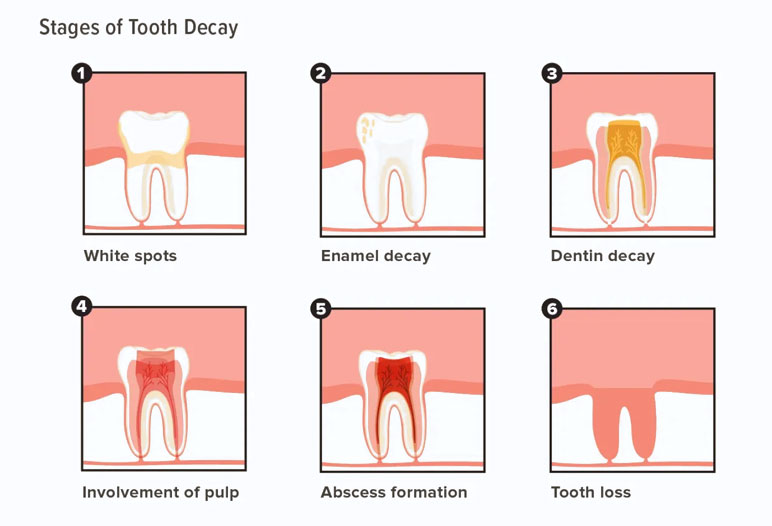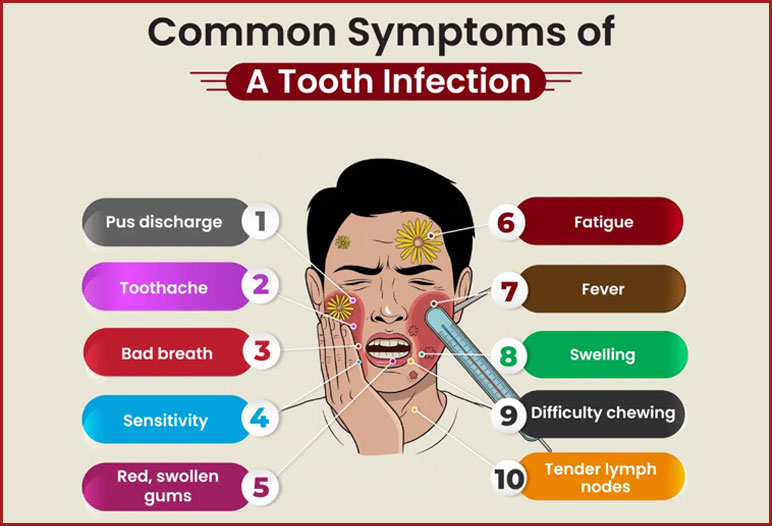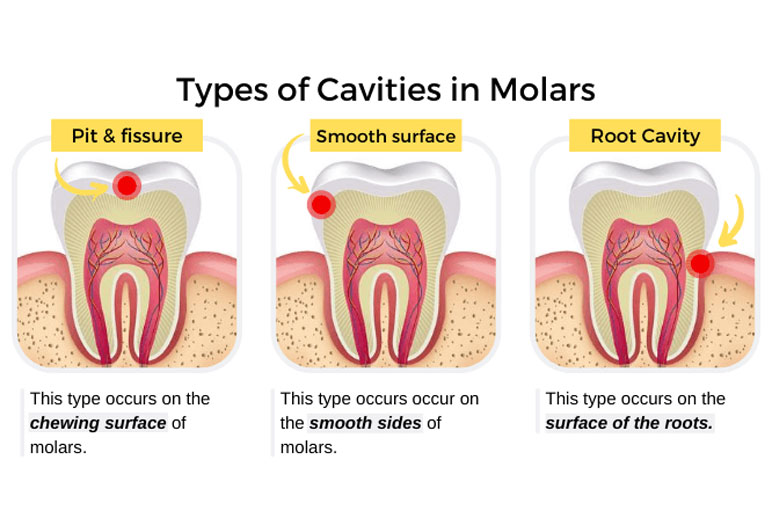When it comes to dental health, one of the most pressing questions many people ask themselves is, can tooth decay spread? The answer, unfortunately, is yes. Tooth decay is a progressive condition that can worsen over time if not treated in its early stages. Understanding how cavities form, progress, and affect the overall health of your teeth and gums is crucial for maintaining optimal oral hygiene.
Can tooth decay spread?
Tooth decay begins as a simple cavity—a small hole or soft spot on the tooth surface caused primarily by bacteria. However, it’s essential to recognize that this seemingly minor issue can escalate quickly if left untreated.
The bacteria present in our mouths produce acids that erode tooth enamel. As a result, these acids create small holes in the enamel, which allow bacteria to penetrate deeper into the layers of the tooth. If you ignore the early signs of tooth decay, such as sensitivity or mild pain, the cavity can spread into more serious issues, including infections that reach the dental pulp. This not only has implications for the specific tooth in question but can also have widespread effects on your overall oral health.

Anatomy of the Tooth
Understanding the anatomy of a tooth will illuminate why the dental pulp is so susceptible to damage. Each tooth comprises three main components:
- Enamel: The hard, protective outer layer that shields against decay.
- Dentin: The softer layer beneath the enamel that provides structural support but is more vulnerable to bacterial invasion.
- Pulp: The innermost layer housing nerves and blood vessels vital for the vitality of the tooth.
As decay penetrates deeper, the risk of infection increases exponentially, underscoring the critical nature of protecting the pulp cavity.
Signs indicating pulp involvement
When decay reaches the dental pulp cavity, the signs are often unmistakable. Patients typically report:
- Stabbing pain that can persist even without external stimulation.
- Significant sensitivity, particularly when consuming temperature extremes in food and drink.
- Difficulty chewing or biting due to sharp pain.
These symptoms should never be ignored, as they indicate a severe issue that requires prompt dental attention to avoid further complications.
Impact of untreated dental pulp cavity
If not addressed, an untreated dental pulp cavity can lead to severe consequences.
- An abscess may form at the root of the tooth, leading to localized swelling and extreme discomfort.
- The infection can spread to neighboring teeth and even to systemic environments, posing risks to overall health.
Understanding these implications emphasizes the urgency of seeking treatment once symptoms manifest.
Understanding the progression of tooth decay
The journey of tooth decay typically follows a distinct pathway. Initially, a cavity may form on the enamel, the outermost layer of the tooth. From there, if the cavity goes untreated, it can progress to the softer dentin layer beneath the enamel. Finally, the bacteria can infiltrate the dental pulp, leading to severe complications requiring immediate attention.
Every stage of this progression carries its own set of risks and symptoms. Recognizing these signs early can help you seek timely treatment and prevent the decay from spreading further.
Symptoms of spreading tooth decay
As tooth decay progresses, the symptoms you experience will likely become more pronounced. While initial cavities might not cause noticeable discomfort, as the decay spreads, you may begin to feel:
- Increased sensitivity to hot and cold temperatures
- Pain that lingers longer than 10-15 minutes
- Discomfort when eating or drinking
- A persistent bad taste in the mouth
Understanding these symptoms is crucial, as they serve as warning signals that your dental health is at risk. Ignoring them could ultimately lead to more severe consequences, including the need for invasive treatments like root canals or even tooth extraction.

Consequences of untreated tooth decay
If you find yourself dismissing the signs of tooth decay, consider the long-term implications. Beyond just discomfort, untreated cavities can lead to infections that may spread beyond the affected tooth, potentially resulting in an abscess or even systemic health issues.
Your body’s response to an infection can also vary. For some, the pain may be debilitating, requiring more than just over-the-counter pain relief. By understanding these risks, you empower yourself to prioritize regular dental checkups, ensuring any potential issues are caught early before they spiral out of control.
Pulp cavity
A pulp cavity forms when the bacteria causing tooth decay reach the innermost layer of the tooth—the dental pulp. This area contains numerous blood vessels and nerves that play essential roles in tooth vitality. When bacteria invade this sensitive space, it can lead to intense pain and a host of other complications, marking a significant turning point in the decay process.
What happens during pulp infection?
When the dental pulp becomes infected, a condition known as pulpitis occurs. The inflammation causes swelling within the confined space of the tooth, leading to immense pressure and pain. This scenario often results in the following symptoms:
- Severe toothache that can radiate through the jaw
- Increased sensitivity to temperature changes
- Swelling in the surrounding gums
- Possible fever or malaise due to systemic infection
Recognizing these symptoms is critical; neglecting them can lead to more severe conditions, including abscess formation.
Treatment options for pulp cavity
Once a cavity has reached the pulp, treatment becomes essential. Two primary methods exist to address a pulp cavity: root canal therapy or tooth extraction.
During a root canal, your dentist will carefully remove the infected tissue and clean the pulp chamber, sealing it to prevent future infections. This procedure usually requires multiple visits, depending on the extent of the damage. Alternatively, if the structural integrity of the tooth has deteriorated significantly, extraction may be necessary.
Aftercare following treatment
After treating a pulp cavity, focusing on aftercare is essential for optimal recovery. Dentists often recommend maintaining excellent oral hygiene practices, including brushing and flossing regularly. Follow-up visits are also vital to ensure the tooth heals properly and no further infections arise.
Moreover, your dentist may suggest placing a crown or filling to restore the tooth’s shape and function. This step serves not only to protect the tooth but also to help restore aesthetics, allowing you to smile with confidence again.
Cavity in molar
Focusing on a common area of concern—cavity in molar—is particularly relevant given the unique structure and function of molars. These back teeth are designed for grinding food, making them especially susceptible to decay if proper care isn’t taken.
Molars and their vulnerability
Molars feature grooves and pits that can trap food particles and plaque easily. This makes it essential to maintain diligent oral hygiene, as the areas between and around molars can harbor bacteria that lead to decay.
- Over time, neglecting these hard-to-reach areas can lead to extensive decay, which often goes unnoticed until it becomes a serious problem.

Signs of cavities in molars
Cavities may develop in molars without much notice due to their location. Initial signs can include:
- Sensitivity during chewing, particularly if food touches an affected area.
- Discoloration or visible holes in the molar surface.
- Bad breath that doesn’t improve with regular brushing.
Being alert to these signs can help you catch cavities in their earlier stages, preventing the need for more extensive treatments.
Treatments for molars affected by cavities
Treatment for cavity in molar generally involves similar approaches as with other teeth, including:
- Dental fillings to restore the structure of the tooth.
- Crowns if the decay is severe enough to compromise the tooth’s integrity.
Your dentist will determine the best treatment based on the extent of the decay and the overall health of your dental structure.
Conclusion
In summary, navigating the complex world of dental health reveals that indeed tooth decay can spread rapidly if not addressed early. From the moment a cavity appears, the clock begins ticking, urging us to take action before the decay escalates into more serious complications like pulp cavities or severe infections.
Understanding the underlying mechanisms of tooth decay, along with the importance of preventive care, equips you to make informed decisions about your dental health. Remember that knowledge is power: maintaining regular dental checkups, adopting stringent oral hygiene practices, and fostering awareness about the signs of decay will help you keep your smile healthy and vibrant for years to come. Your teeth deserve the best care, and by prioritizing their health today, you’re investing in a brighter, pain-free tomorrow.



SAIGON CENTER DENTAL CLINIC
Best dentist in Vietnam
Saigon Center Dental Clinic is proud to be one of the most prestigious dental clinics in Ho Chi Minh City with a variety of services: Single dental implant, Full jaw dental implant (especially All On 4, All on 6, and Zygoma Implant), Cosmetic porcelain crowns, Porcelain veneers, Braces, Clear braces, Tooth fillings, Wisdom tooth extraction, Treatment of toothache...
SAIGON DENTAL IMPLANTS CENTER
Best dentist in Vietnam
Saigon Implant Center - Dental Clinic utilizes the latest technology for specialized treatment in the field of Single implant, full jaw implants, All on 4 implants, All on 6 implants, Zygoma implant....